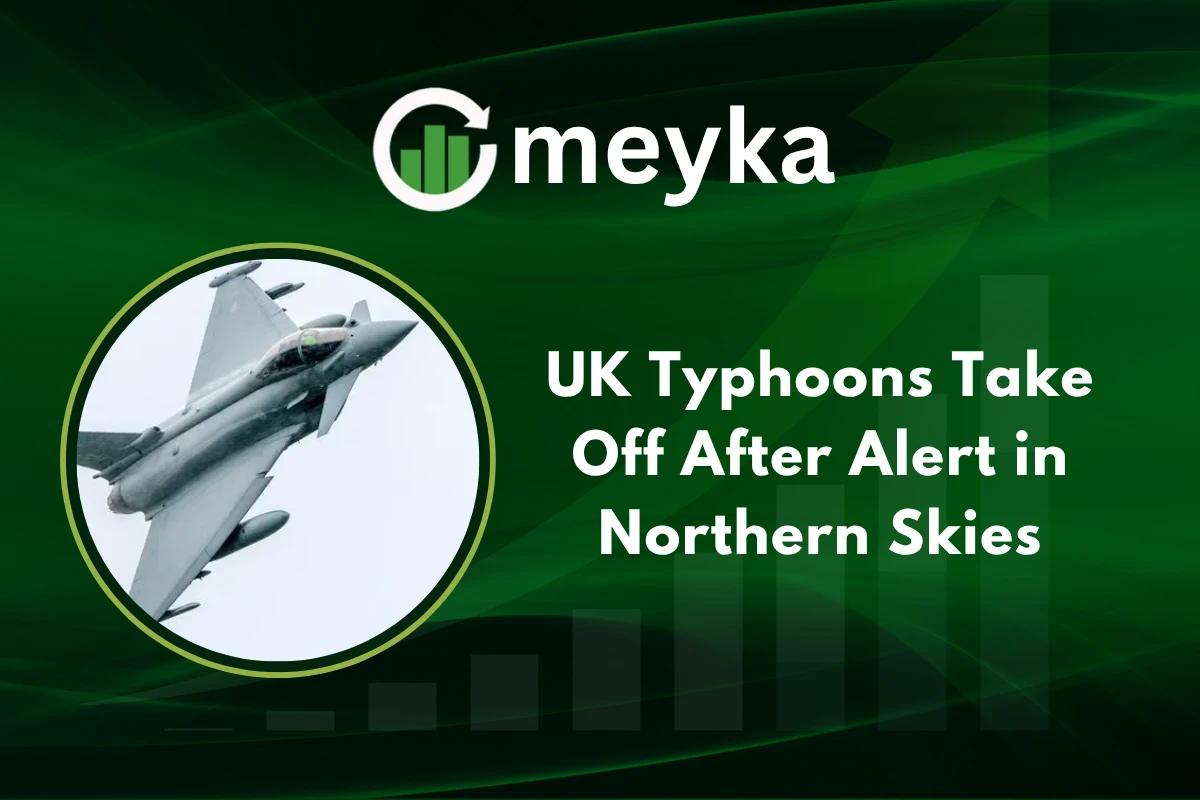UK Typhoons Take Off After Alert in Northern Skies
A pair of UK Typhoons launched from RAF Lossiemouth after an alert in the northern skies on Tuesday. The Quick Reaction Alert mission saw the jets supported by a Voyager tanker as they raced north over the North Sea to monitor an unidentified aircraft approaching the UK’s area of interest.
The aircraft did not enter UK airspace and no interception was required, but the launch underlined the RAF’s constant readiness to protect Britain’s skies.
UK Typhoons Scrambled After Northern Skies Alert
Two Eurofighter Typhoon jets were scrambled as part of a routine but urgent air-defence response from RAF Lossiemouth. The mission was backed by an RAF Voyager tanker from Brize Norton, tracked moving north and operating in standard air-to-air refuelling patterns west of the Shetland Islands.
This refuelling gave the Typhoons the endurance to patrol and remain on station while the situation was monitored. The RAF confirmed the aircraft did not enter the UK Flight Information Region and that no interception took place.
Why were UK Typhoons scrambled?
Quick Reaction Alert (QRA) launches can be ordered for several reasons: unidentified aircraft approaching the UK’s area of interest, foreign military flights near UK-controlled airspace, or civilian aircraft that have lost communications.
The goal is immediate identification and deterrence, ensuring the UK retains sovereign control of its airspace. The recent scramble was triggered by an unidentified radar contact that required investigation.
RAF Quick Reaction Alert – How It Works
The Quick Reaction Alert system is the heart of the UK’s airborne defence posture. QRA units are on 24/7 standby and ready to launch within minutes to intercept and assess potential threats. Typhoons normally operate from bases such as RAF Lossiemouth and RAF Coningsby, equipped for rapid take-off and fast response. Voyager tankers extend the reach and endurance of QRA missions, enabling patrols far from UK soil.
What is a Quick Reaction Alert?
A QRA is an immediate scramble tasking to identify, monitor, and, if necessary, escort or intercept aircraft. The RAF’s QRA page explains that this capability is central to protecting UK airspace and supporting NATO collective defence. Quick Reaction Alert is not uncommon; scrambles happen regularly to ensure fast, reliable responses to evolving aerial situations.
What Role Do UK Typhoons Play in NATO Air Defence?
UK Typhoons are a key part of NATO air defence. They operate as the Royal Air Force’s primary fast-response interceptor and multirole fighter, and they regularly coordinate with NATO partners to defend wider airspace.
When unidentified aircraft approach the UK’s Flight Information Region, the RAF often assumes responsibility or hands off to allied QRA assets as part of a cooperative air-defence network. This pooling of responsibility helps secure large oceanic areas like those north of Scotland.
Public and Media Reaction to the Typhoon Response
News of the scramble drew attention online and in defence circles. Local and national outlets covered the launch, and social media tracked the tanker’s flight path and the Typhoons’ activity.
Public reaction tends to be a mix of reassurance, seeing jets protect the skies, and curiosity about the origin of the unidentified aircraft. The RAF’s quick public confirmation helped calm speculation by stating clearly that no interception occurred.
Should the public be worried about these scrambles?
No. While any scramble is taken seriously, QRA missions are routine and designed to protect the public. A launch often ends with the aircraft returning to base once identification is complete. The presence of tankers and long-range patrol patterns is a normal part of maintaining airspace security.
How Often Are UK Typhoons Scrambled?
The RAF conducts QRA launches regularly as part of its continuous defence mission. The number of scrambles can vary with global events, training cycles, and routine checks. Not every launch results in an interception; many scrambles confirm that an aircraft is harmless or operating just outside the UK Flight Information Region. The key is readiness; jets and crews remain poised to respond around the clock.
What Happens After an Alert Is Resolved?
Once the unidentified contact is assessed and no threat is identified, the Typhoons return to base and command conducts a post-mission review. The RAF may coordinate with NATO or regional partners to trace the aircraft’s origin and ensure lessons are learned for future sorties.
Investigations and reporting help refine procedures and ensure continued airspace integrity. Transparency in reporting reduces public alarm and improves operational readiness.
UK Typhoons in the Wider Defence Context
This scramble illustrates several broader points about the UK’s defence posture. First, airspace security relies on rapid detection, clear rules of engagement, and strong logistics such as tanker support.
Second, Typhoons are a vital deterrent and a visible sign of the UK’s commitment to NATO and regional security.
Finally, routine scrambles demonstrate that the RAF is prepared to meet both routine and unusual aerial events quickly and decisively.
What does this mean for national security?
It shows the UK maintains robust air-defence capabilities and strong allied coordination. Regular QRA missions and multinational cooperation reinforce deterrence and contribute to regional stability. For citizens, the message is one of preparedness and control.
The Road Ahead, Readiness, Investment, and Public Confidence
Looking forward, the RAF will keep investing in readiness: training, upgrade programmes for Typhoons, and continued tanker support are likely priorities. The frequency of scrambles will track with geopolitical tensions and routine policing tasks. Steady communication from the RAF and allied partners will be essential to maintain public trust and operational effectiveness.
Conclusion
UK Typhoons took to the northern skies in a textbook Quick Reaction Alert mission that underlines the Royal Air Force’s constant vigilance. The jets, supported by a Voyager tanker, checked an unidentified approach, then returned to base once the aircraft proved not to be a threat.
These missions are routine, but vital; they protect UK airspace, reassure the public, and keep the nation ready alongside NATO allies. The recent scramble is a reminder that air defence is an ongoing, collaborative effort requiring speed, coordination, and clear public communication.
FAQ’S
Yes, the RAF still operates UK Typhoons as their primary multi-role fighter jet. They remain central to air defence, NATO operations, and Quick Reaction Alerts.
Russian aircraft sometimes approach the UK’s area of interest, but UK Typhoons intercept them before entering sovereign airspace. No confirmed incursions into UK airspace have occurred.
Yes, the UK has a fleet of Eurofighter Typhoons, built in collaboration with European partners. They are stationed mainly at RAF Lossiemouth and RAF Coningsby.
Yes, in rare cases RAF Typhoons have been scrambled to escort unresponsive private jets, and their high-speed interception can create a sonic boom heard on the ground.
The United States is often regarded as having the most advanced fighters, such as the F-35 and F-22, but UK Typhoons remain among the most capable jets in Europe.
No, commercial planes avoid typhoons due to extreme winds and turbulence. The term “Typhoon” here refers to weather, not the UK Typhoons fighter aircraft.
Disclaimer
This is for information only, not financial advice. Always do your research.






